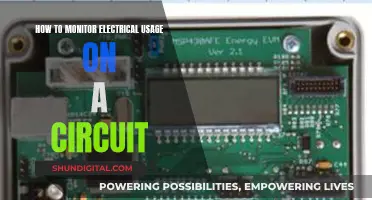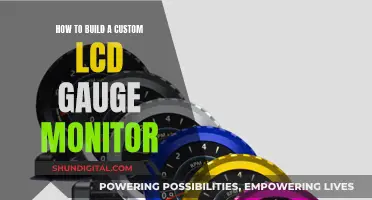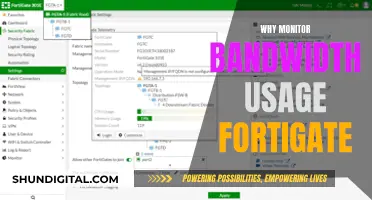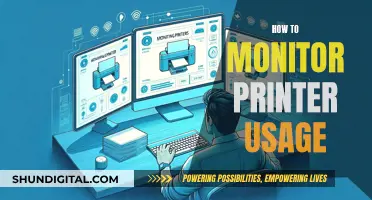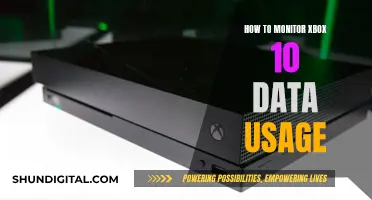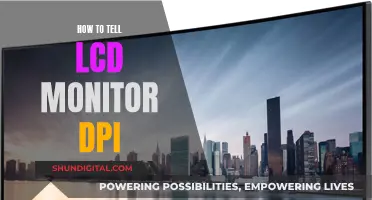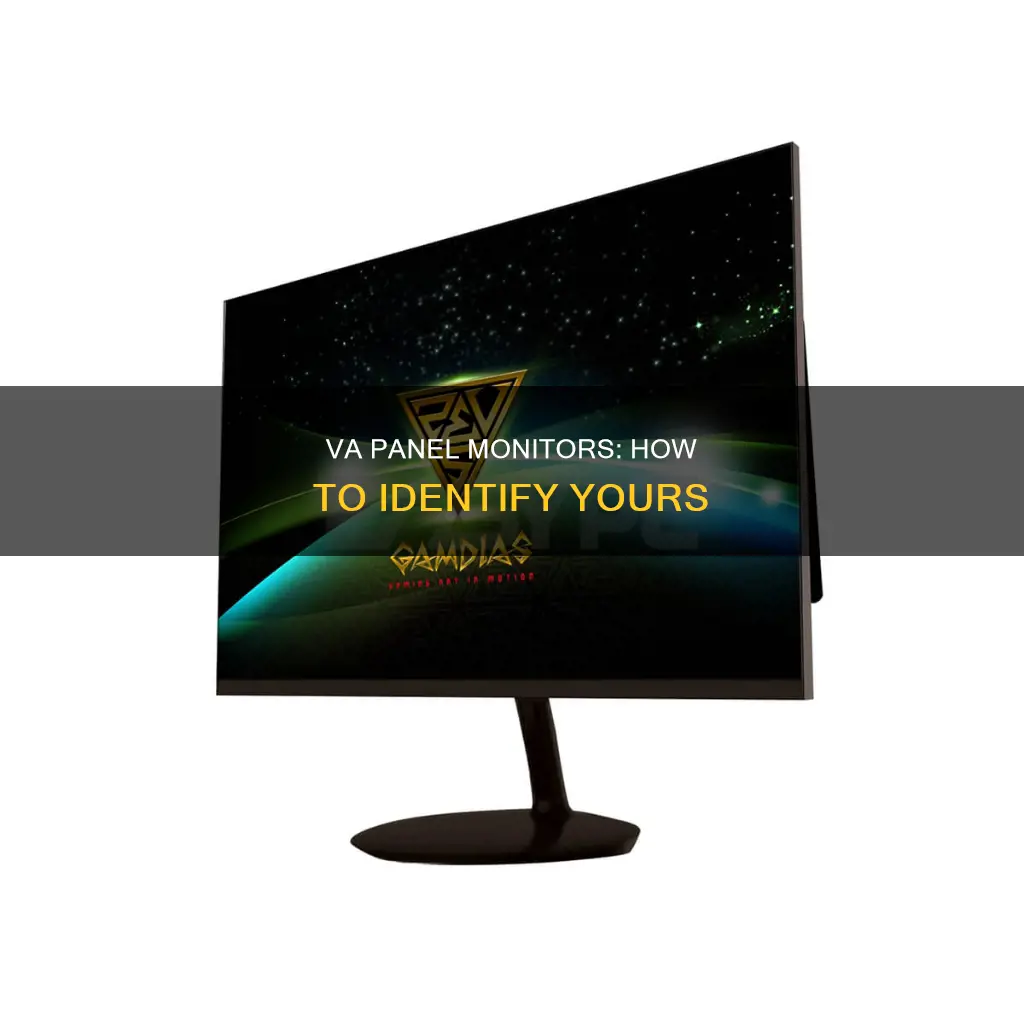
There are a few ways to tell if your monitor is a VA or vertical alignment panel. VA panels are one of the three most common types of LCD panels, the other two being IPS or in-plane switching and TN or twisted nematic. VA panels have vertically aligned crystals that tilt to allow light to pass through. VA panels have a wider viewing angle and sharper colours than TN panels, and a higher refresh rate than IPS panels. They also have high-contrast black levels, so the difference between light and dark is clearly visible. However, VA panels have a high response time, meaning they don't react to changes as fast and fast movements are less sharp.
| Characteristics | Values |
|---|---|
| Viewing Angle | Up to 178 degrees |
| Color Accuracy | High, but not uniform across the screen |
| Color Coverage | Good, but not as good as IPS |
| Contrast Ratio | High (2000:1 to 5000:1) |
| Black Levels | High-contrast |
| Response Time | Slow (4-5ms) |
| Refresh Rate | High (144Hz to 240Hz) |
| Motion Handling | Poor |
| Ghosting | Prone to ghosting |
What You'll Learn

VA panels have a wider viewing angle and sharper colours than TN panels
VA panels, or Vertical Alignment panels, are a compromise between TN and IPS panels. They offer excellent contrast ratios, which is why they are used extensively in TVs. While an IPS monitor typically has a contrast ratio of 1000:1, a VA panel can have a ratio of 3000:1 or 6000:1. This makes VA panels ideal for HDR content.
VA panels also have wider viewing angles than TN panels. TN panels have limited viewing angles, particularly on the vertical axis. It is not unusual for a TN panel's colours to invert completely when viewed from an extreme angle. VA panels, on the other hand, can maintain colour accuracy and contrast consistency from almost any angle.
VA panels also offer much better colour reproduction than TN panels and typically hit the full sRGB spectrum, even on lower-end models. This is because VA panels have crystal molecules aligned vertically and perpendicular to the glass substrate, which tilt to let the light pass through. This provides decent picture quality and good colour reproduction.
In summary, VA panels offer a great all-round package with excellent contrast ratios, wide viewing angles, and good colour reproduction. They are ideal for general use and for gamers who enjoy single-player or casual experiences.
Is My Monitor 144Hz? Here's How to Check
You may want to see also

VA panels have a higher refresh rate than IPS panels
IPS is capable of significantly higher refresh rates than VA. IPS can hit 500Hz, while VA caps out at 240Hz. The vast majority of VA displays are only capable of 144Hz or 165Hz. There are only a few VA monitors that can do 240Hz. For those wanting extremely high refresh rates, IPS is the clear winner.
Even if VA was capable of 360Hz, it probably wouldn't be very good because of its weakness in response times. A 360Hz display refreshes every 2.7ms, which is well below what VA is generally capable of.
While IPS displays are usually a safe recommendation for most people, there are very good reasons to buy VA monitors and TVs. VA has found its home in mid-range gaming monitors, gaming TVs, and ultrawide displays. Many of the best gaming monitors use VA.
IPS panels are by far the most common on today's monitors. Although VA panels aren't as common as IPS panels for monitors, they are one of the most common choices for TVs.
LCD Monitors: Eye Strain Culprits or Just Another Screen?
You may want to see also

VA panels are great for displaying deep blacks
The contrast ratio of a VA panel can be more than double that of an IPS panel, and up to six times that of a TN panel. A higher contrast ratio means that the difference between the brightest white and the darkest black that a panel can display is more pronounced. This results in deeper blacks and brighter whites, improving the overall picture quality.
When choosing a VA panel monitor, it's important to look at the specifications to ensure you get one with deep blacks. The contrast ratio is a key specification to consider, with higher ratios resulting in deeper blacks. Look for a static contrast ratio of at least 3000:1, with the best VA panels offering ratios of 5000:1 or higher. However, keep in mind that these high-contrast VA panels are more commonly found in TVs than in computer monitors.
Another factor that can affect the black level and contrast of a VA panel is the refresh rate. High refresh rate VA screens tend to have worse contrast and black levels than their 60Hz counterparts. This is because achieving higher refresh rates often comes at the cost of sacrificing other aspects of the panel's performance. Additionally, the coating or surface material of the screen can also impact the perceived contrast and black level. A glossy screen can improve the perception of contrast, while a matte screen can degrade the black level and contrast due to light diffusion.
While VA panels offer superior black levels and contrast compared to IPS and TN panels, they may fall short in other areas. VA panels typically have slower response times, especially in near-black scenes, which can result in dark trails behind fast-moving objects, known as black smear. They also tend to have worse viewing angles than IPS panels, with color accuracy degrading and brightness decreasing at moderate angles. However, these drawbacks may be acceptable compromises for users who prioritize deep blacks and high contrast.
How LCD Screens Emit Light
You may want to see also

VA panels are not ideal for image editing
VA panels also suffer from black smearing, which can be a nightmare for image editing, and black crush, where the screen takes on a bluish tint when displaying dark scenes.
While VA panels are great for producing deep blacks and have a high contrast ratio, which is good for gaming and entertainment, they are not ideal for image editing, where color accuracy is key.
IPS panels are the preferred option for image editing, as they offer extreme and precise color accuracy.
Asus Monitor Warranty: A Lifetime Promise?
You may want to see also

VA panels are a good middle option between IPS and TN panels
VA panels were popularized by the Japanese company Fujitsu and are considered the sweet spot between IPS and TN. They have crystal molecules aligned vertically and perpendicular to the glass substrate, which tilt to let light pass through. This provides decent picture quality.
VA panels have excellent contrast ratios, which is why TV manufacturers use them extensively. While an IPS monitor typically has a contrast ratio of 1000:1, it's not unusual to see 3000:1 or 6000:1 in a comparable VA panel. They also have good response times of 2-3ms with a 178-degree viewing angle, similar to IPS technology.
VA panels do offer much better colour reproduction than TN panels and typically hit the full sRGB spectrum. If you're willing to spend a bit more, Samsung's Quantum Dot SVA panels can hit 125% sRGB coverage.
However, VA panels have slower response times than IPS and TN panels. They also have slow pixel transitions, and this latency results in blurred trails in fast-moving visuals, causing visible ghosting. As such, it’s not a good choice for competitive gaming.
Overall, VA panels are a good middle option if you're looking for a monitor that can handle a wide range of tasks and don't mind compromising on response times.
Monitoring Home Electrical Usage: Service Panel Edition
You may want to see also
Frequently asked questions
VA monitors have a wider viewing angle and sharper colours than TN panels, and a higher refresh rate than IPS panels. They also have high-contrast black levels, so the difference between light and dark is clearly visible.
VA panels have a high response time, meaning they don't react to changes as quickly as other panels. This means fast movements are less sharp. VA panels also tend to have issues with motion content, colour shift, ghosting and black smearing.
IPS panels have traditionally been used for displays that have high colour accuracy and large coverage of wide colour gamuts. They also have wider viewing angles than VA panels, so you don't need to be directly in front of the screen to get accurate colours. VA panels have issues with colour accuracy and uniformity, but this is only likely to be an issue for professional photo and video editors.


